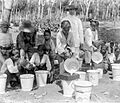Cultivation System facts for kids
The Cultivation System (called cultuurstelsel in Dutch) was a special rule from the Dutch government. It was used in their colony, the Dutch East Indies (which is now Indonesia), from 1830 to 1870. This rule made people grow certain crops for export. Indonesian historians call it tanam paksa ("enforced planting") because people were forced to do it.
Why the System Started
By the late 1700s, the old Dutch East India Company was losing money. Their way of doing business, which relied on controlling markets, was not working anymore. The Dutch part of Java made very little money.
Later, the government in the East Indies faced big money problems. This happened because of expensive wars, like the Padri Wars (1821–1837) and the Java War (1825–1830). Then, in 1830, the Belgian Revolution made the Netherlands itself have money troubles. The country was almost bankrupt.
In 1830, a new leader named Johannes van den Bosch became the Governor-General of the Dutch East Indies. His main job was to make the Dutch East Indies produce more wealth. The Cultivation System was his idea. It was only used on land directly controlled by the Dutch government. Some special areas, like princely states, were not included.
How the System Worked
The Cultivation System was mostly used on the island of Java. Java was the main center of the Dutch colony. Instead of paying land taxes, villagers had to use 20% of their land to grow crops for the government. These crops, like sugar or coffee, were meant for export.
Another option was for farmers to work on government-owned farms for 60 days each year. To make sure people followed these rules, Javanese villagers were closely tied to their villages. Sometimes, they could not travel freely around the island without permission.
In theory, only 20% of land was used for export crops. But in reality, much more land was often taken. Sometimes, almost all the land was used for these crops. This meant local people had little land left to grow food like rice. This led to serious food shortages and even famines in many areas. Also, farmers often had to work much longer than 60 days.
The Dutch also set up a system with local helpers to manage the crops. These helpers made a lot of money from the system. The system was partly paid for by selling bonds in the Netherlands. It also used new copper coins. These coins were worth less than their stated value, which helped the Dutch government gain more money.
What Happened Next
The Cultivation System brought huge wealth to the Netherlands. Exports grew a lot, by about 14% on average. It helped the Netherlands recover from its financial problems very quickly. By 1831, the Dutch East Indies government had enough money to cover its costs. The extra money was even used to pay off old debts.
However, the system also caused big problems. In the 1840s, there were famines and diseases in places like Cirebon and Central Java. This happened because farmers had to grow cash crops like indigo and sugar instead of rice, which was their main food.
People in the Netherlands started to protest against the system. Some independent merchants also wanted free trade instead. Eventually, these pressures led to the system being stopped. New laws in 1870, like the Suikerwet and the Agrarische Wet, ended the Cultivation System. This marked the start of the Liberal Period, where private businesses were encouraged.
See also
- Landrentestelsel
- Max Havelaar
Images for kids
-
Collecting natural rubber in a plantation in Java. Rubber trees were brought by the Dutch from South America.



